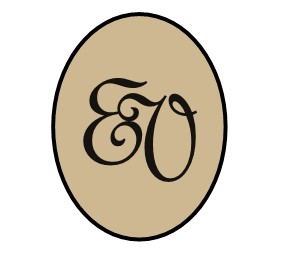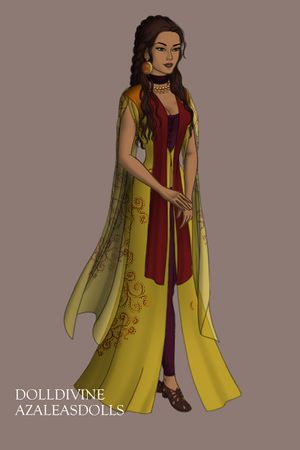Elanthian Vogue/Imaerasta 5120
This Month's Edition
Editor-in-Chief: Rohese Bayvel-Timsh'l
Editor's Thoughts
I don't know about you but I get very excited at this time of the year. The days are still fairly long and relatively warm - unless you live in Icemule - but there is a definite feeling of change in the air. Fall brings to mind rich autumnal colors, the smell of woodsmoke and damp leafy loam, cozy evenings by the fire with a book, and of course, the Ebon Gate Festival. But before we wish away the weeks leading up to the re-opening of Caligos Isle, we should take a moment to appreciate this transition into the next season and its fashionable highlights.
Loose layers and lively colors have long been a wardrobe staple for many cultures but the trend is in full force for everyone this fall. This month's edition of Elanthian Vogue takes a look at exotic fashion and offers you some ideas and styles for a fall-into-winter wardrobe, including inspiration from Tehir and Erithian clothing. Some fashion-forward socialites have even been spotted adopting exotic pets as accessories and we share a few examples with you in a special EV EXTRA!.
We also reveal the Imaerasta portrait from the 5119 Vogue Gallery and begin to give some thought to our year-end presentation for 5120. The offices of Elanthian Vogue have been buzzing with ideas and we are excited about the proposals so watch this space and perhaps keep an eye out for a courier bearing a message about your possible inclusion in this year's celebrated Gallery!
As always, don't forget to send us your comments on any of the articles in this month's publication or suggestions for future editions!
Editor
Exotic Fashion
An exotic fashion style is definitely interesting. It incorporates so many diverse and unusual elements and the popularity of the style is growing as fashionistas from all around Elanthia have started to showcase outfits featuring a blend of exotic elements from various cultures. It is a clothing style that is centered on rich smoky colors, mysterious ornate patterns, mosaics, iridescent textures, shiny jewelry and long flowing lines.
Layered robes and loose-fitting shifts or tunics are the centerpiece of the exotic fashion style. Ever since kimonos became available for purchase at the historic Valley of Gold event in 5119, we have seen flowing and voluminous garments become increasingly more popular. Such items are readily available in many town stores and they are highly versatile; it is easy to adapt them to suit any occasion or event.
For the ultimate "style steal", we look to the Tehir for a primer on exotic fashion with their proclivity for veils or head scarves, layered airy fabrics, and elaborate tattoos. But if you are looking for a more casual version of the exotic style, you might consider an Erithian wardrobe. Based on an embroidered atanika or any other suitable robe, simply add kanjir, nanjir, or basic leggings and brightly colored headwear. In a similar vein, the denizens of Mist Harbor have developed their own vibrant clothing style that can be easily adopted with cross-body drapes (commonly referred to as saewehni), saephuas, and billowing serwals.
We cannot talk about exotic styling without actually thinking of more than just the clothes. For starters, the hairstyles are really interesting. The signature hairstyle of the Tehir is long dark locks – often knotted and occasionally beaded; short hair is generally avoided. Wigs can be quite easily utilized by those with shorter hair to embrace this style.
Clothes are always complemented with striking make-up. We already mentioned that the general trend is highly influenced by Tehiri elements and the same thing applies to make-up. Henna body art and kohl-lined eyes are almost always present, together with silver, gold, copper and smoky shadows for that ultimate exotic effect.
The last element to be implemented is accessories such as ornate jewelry. Cuffs, bangles, and earrings are always great additions. It is possible to add intricate designs to suit practically any outfit you wear. Some of the more fashion-forward even go so far as to incorporate live exotic animals or pets as accessories and we feature several examples in the aforementioned EXTRA included with this edition. If the thought of a furry, feathered or scaly addition doesn't appeal, simply take inspiration from the animal kingdom and display it in the form of a brooch or pendant. Bear in mind that the creature you align with – whether a live specimen or a bejeweled or plumed representation - can speak volumes about your personality and style, so wear it with attitude!
On the Spot
Every now and then we take the opportunity to put someone "on the spot" with 5 random questions to gain a quick peek into their lifestyle choices. This month, given the theme, we are delighted to put two fascinating and equally exotic personalities "on the spot."
Hadya
First, we were privileged to spend time with Hadya Kha'Taymullah of the Tehir tribe who agreed to answer a few of our questions.
You see Hadya Kha'Taymullah the High Priestess of Luukos. She appears to be a Human of the Tehir tribes. She is short and has a thin petite frame. She appears to be very young. She has viridian-hearted dark amber eyes and smooth, pale copper skin. She has very long, sable hair that falls in a lustrous curtain of thin braids to her thighs. She has a slender face, the bone-structure of which further accents her delicate features. She has a jagged, scale-indented scar across her neck. Her waist is narrow. She has a sinuous diamondback rattlesnake languidly draped across her shoulders, its eyes half-lidded. She has a thin column of serpentine malachite tracery tattooed on her chin, a wavy ophidian mark, matching tattoos of sinuous malachite script winding around her forearms, and an intricate tattooed malachite pattern that covers the back of her hands. She is wearing a bronze serpent headpiece suspending a floor-length train of etched copper scales, some talon-set dark emerald prayerbeads, and a sleeveless overrobe of cacao hued silk which cascades into a peridot-beaded train over an emerald dupioni underrobe with split floor-length sleeves, a bronze-framed bone reliquary, a carved copper asp ring, a silver serpentine ring, and a pair of coppery suede sandals.
Tell us a little bit about yourself. I am Hadya, first daughter of Taymullah, first son of the first wife of Raeshaek Chieftain of the Senkara Tribe. I am the Servant of Ek'Saap or as He is called in the wetlands, Luukos.
Could you try and explain to our readers what it means to be Tehiri. To be Tehiri is to be forged in the sands of the Sea of Fire. It is to know thirst, to be water thin. It makes us strong where others might be weak. It means we can thrive where others would not dare to tread.
What does the term "exotic" bring to mind? I am told by many that Tehir are exotic. To me, this word means strange and different. I find the wetlanders to be exotic, strange, different ... I am still awed that people bathe in large bodies of water and that there are always fruits to eat. Such a thing is a luxury, I find many here take it for granted that they have such a bounty laid before them. To be water fat is exotic where I am from.
How important is clothing and fashion to you? Fashion is how I cling to my identity as a tribeswoman; it keeps me grounded in that knowledge. No matter what, I am forged in the sands of Shaga's breast. From bone, to flesh ...
My favorite pieces are those I use in ritual which diverge a bit from Tehir fashion, but I will show you some pieces that are unique:
an asp-framed dark emerald pendant
Age has tarnished the crevices between the intricately wrought scales of the golden asp, though the surface remains smooth and brightly polished. The snake winds its way around the edge of a large round dark green emerald, with the tip of its tail forming a loop to allow the pendant to dangle from a chain. The depths of the gloomy green gem are further shadowed by a black steel backing. Inscribed on the back of the black steel is a phrase in stylized Tehir writing. In the Tehir language, it reads: Those who seek Doom often find it.
a carved copper asp ring
The ring is petite and is made to fit a slender finger. Oxidation has taken place between the intricately wrought scales, leaving a verdant hue and giving dimension to the polished surface of the scales. The ring is fashioned to look like an asp devouring its tail. Its cold, cruel stare is fashioned from two small emeralds which flash viridian fire when hit by the slightest light. Etched across the back as a stern reminder are the words "None for myself, all for The Great Serpent."
some talon-set dark emerald prayerbeads
Rounds of emerald nestle into settings of bronze that resemble taloned claws, and the mounted links are joined by delicate chains. Each barb bites into its stone, holding it securely in place and creating a cruel display that is echoed in the clasp. Half of the toggle is an asp, its body twisted into an open-work knot, and the other half is a single talon of bronze. The tip, stained crimson, fits perfectly within the hollows of the asp's coils, appearing to pierce the creature as it secures the strand.
Would you be willing to share a brief insight into some of the rituals and traditions that you adhere to? As many Tehiri Shaman, I carry spirit pacts upon my skin in malachite ink. These pacts are of course agreements between myself and the spirits I call upon to draw power for spells, each mark upon my skin, is a promise to a spirit. They take time to accumulate, you see many older shaman covered head to toe in inked pacts. Such is our way.
The ritual I often use to raise others, is a form of blood magic my tribe uses to tie the spirit to the body ... to prevent jealous spirits from taking the recently deceased's place with in it. Jealous spirits always look to find a vessel, one must guard against them.
I do not sing outside of rituals. A woman's voice is strong and will draw spirits. We believe that women are the houses of the spirits. We give spirits flesh; we are their conduits. Thus, singing outside of sanctioned rites is forbidden by my tribe.
Akaal
Not of the Tehir, Akaal has a unique and exotic styling all of his own and we were also honored to be able to spend some time with him.
To follow.
Vogue Gallery
Pre-empting the theme of next month's edition, we are proud to present the Imaerasta portrait from the 5119 Vogue Gallery. Regular readers of Elanthian Vogue will be familiar with Vincien as he is one of our most-featured reporters and a popular choice for lifestyle interviews. His reputation as a charmer with women notwithstanding, he is an advocate of fashion trends, good wine, good food, and good company.
Imaerasta Vincien Bales of hay have been stacked in neat blocks to form a makeshift golden throne on which sits a broad-shouldered elf with brooding dark, ink blue eyes beneath well-defined eyebrows. His leisurely pose and wide grin hints at an affable personality and this is reinforced by the pair of scantily clad sylvans seated at his feet with beatific expressions. Surrounding the painted scene are examples of a bountiful harvest; baskets of succulent peaches and combs of honey are juxtaposed with bowls of ripe cherries and bottles of rich red wine. Portrait as featured in the 5119 Vogue Gallery

